This is an old revision of this page, as edited by Nanshu (talk | contribs) at 02:18, 13 March 2008 (reverted vandalism by Kangnidofan; heading fixed). The present address (URL) is a permanent link to this revision, which may differ significantly from the current revision.
Revision as of 02:18, 13 March 2008 by Nanshu (talk | contribs) (reverted vandalism by Kangnidofan; heading fixed)(diff) ← Previous revision | Latest revision (diff) | Newer revision → (diff)Ancient world maps cover depictions of the world from Classical times to the Age of Discovery and the emergence of modern Geography.
Antiquity

Babylonian world map
The oldest known world map is the Imago Mundi of 6th century BC Babylonia. The map as reconstructed by Eckhard Unger shows Babylon on the Euphrates, surrounded by a circular landmass showing Assyria, Armenia and several cities, in turn surrounded by a "bitter river" (Oceanus), with seven islands arranged around it so as to form a seven-pointed star.
The accompanying text mentions seven outer regions beyond the encircling ocean. The descriptions of five of them have survived:
- the third island is where "the winged bird ends not his flight," i.e., cannot reach.
- on the fourth island "the light is brighter than that of sunset or stars": it lay in the northwest, and after sunset in summer was practically in semi-obscurity.
- The fifth island, due north, lay in complete darkness, a land "where one sees nothing," and "the sun is not visible."
- the sixth island, "where a horned bull dwells and attacks the newcomer"
- the seventh island lay in the east and is "where the morning dawns."
Anaximander

Anaximander (died ca. 546 BC) is credited with having created the first map of the world, which was circular in form and showed the known lands of the world grouped around the Aegean Sea at the center. This was all surrounded by the ocean.
Hecataeus of Miletus

Hecataeus of Miletus (died ca. 476 BC) is credited with a work entitled Ges Periodos ("Travels round the Earth" or "World Survey'), in two books each organized in the manner of a periplus, a point-to-point coastal survey. One on Europe, is essentially a periplus of the Mediterranean, describing each region in turn, reaching as far north as Scythia. The other book, on Asia, is arranged similarly to the Periplus of the Erythraean Sea of which a version of the 1st century AD survives. Hecataeus described the countries and inhabitants of the known world, the account of Egypt being particularly comprehensive; the descriptive matter was accompanied by a map, based upon Anaximander’s map of the earth, which he corrected and enlarged. The work only survives in some 374 fragments, by far the majority being quoted in the geographical lexicon Ethnika compiled by Stephanus of Byzantium.
Eratosthenes
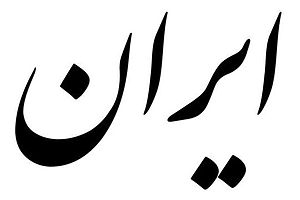
Eratosthenes (276-194 BC) drew an improved world map, incorporating information from the campaigns of Alexander the Great and his successors. Asia became wider, reflecting the new understanding of the actual size of the continent. Eratosthenes was also the first geographer to incorporate parallels and meridians within his cartographic depictions.
Ptolemy

The Ptolemy world map is a map based on the description of the world contained in Ptolemy's book Geographia, written Circa 150. Although authentic maps of Ptolemy have never been found, the Geographia contains thousands of references to various parts of the old world, with coordinates for most, which allowed cartographers to reconstruct Ptolemy's world view when the manuscript was re-discovered around 1300.
Tabula Peutingeriana (4th century)
The Tabula Peutingeriana (Peutinger table) is an itinerarium showing the cursus publicus, the road network in the Roman Empire. The original map dates from the 4th century. It covers Europe, parts of Asia (India) and North-Africa. The map is named after Konrad Peutinger, a German 15-16th century humanist and antiquarian. The map was discovered in a library in Worms by Conrad Celtes, who was unable to publish his find before his death, and bequeathed the map in 1508 to Peutinger. It is conserved at the Österreichische Nationalbibliothek, Hofburg, Vienna.
 The Tabula Peutingeriana, from Britain in the west, to India in the east.
The Tabula Peutingeriana, from Britain in the west, to India in the east.
Cosmas Indicopleustes (6th century)
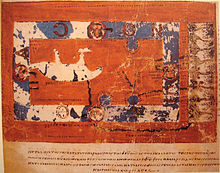
Around 550 Cosmas Indicopleustes wrote the copiously illustrated Christian Topography, a work partly based on his personal experiences as a merchant on the Red Sea and Indian Ocean in the early 6th century. Though his cosmogony is considered by many to be absurd, he has given an historic description of India and Sri Lanka during of the 6th century, which is invaluable to historians. Cosmas seems to have personally visited the Kingdom of Axum in modern Ethiopia and Eritrea, India and Sri Lanka. In 522 CE, he visited the Malabar Coast (South India).
A major feature of his Topography is Cosmas' worldview that the world is flat, and that the heavens form the shape of a box with a curved lid, a view he took from unconventional interpretations of Christian scripture. Cosmas aimed to prove that pre-Christian geographers had been wrong in asserting that the earth was spherical and that it was in fact modelled on the tabernacle, the house of worship described to Moses by God during the Jewish Exodus from Egypt.
Middle Ages

Isidore
Main article: T and O mapThe medieval T and O maps originate with the description of the world in the Etymologiae of Isidore of Sevilla (died 636). This qualitative and conceptual type of medieval cartography represents only the top-half of a spherical Earth. It was presumably tacitly considered a convenient projection of the inhabited portion of the world known in Roman and Medieval times (that is, the northern temperate half of the globe). The T is the Mediterranean, dividing the three continents, Asia, Europe and Africa, and the O is the surrounding Ocean. Jerusalem was generally represented in the center of the map. Asia was typically the size of the other two continents combined. Because the sun rose in the east, Paradise (the Garden of Eden) was generally depicted as being in Asia, and Asia was situated at the top portion of the map.

Anglo-Saxon world map (circa 992 CE)
This map appears in a copy of a classical work on geography, the Latin version by Priscian of the Periegesis, that was among the manuscripts in the Cotton library (MS. Tiberius B.V., fol. 56v), now in the British Library. It is not intended purely as an illustration to that work, for it contains much material gathered from other sources, including some which would have been the most up-to-date available. The estimated date is based on suggested links to the journey of Archbishop Sigeric of Canterbury (992-994) from Rome. Like the later map by al-Idrisi (see below) this map is clearly outside the largely symbolic early medieval mapping tradition, but equally it is not based on the famous Ptolemaic co-ordinate system. East is at the top, but Jerusalem is not in the centre, and the Garden of Eden is nowhere to be seen. Unusually, all the waterways of Africa, not just the Red Sea, are depicted in red (mountains are green). The depiction of the far East is ambitious, including India and Taprobane (Sri Lanka)- the latter depicted according to the exaggerated classical conception of its size. Unsurprisingly, Britain itself is depicted in some detail. Great Britain, unusually by medieval standards, is shown as one island, albeit with an exaggerated Cornish promontory, and Mona, Ireland and the many Scottish islands are all indicated. The cartographer is slightly confused by Iceland, depicting it both by a version of its classical name 'Thule', north-west of Britain, and as 'Island', logically linked with Scandinavia.

Beatus Mappa Mundi (1050 CE)
Main article: Beatus of LiébanaBeatus of Liébana (c. 730 - 798) was a Spanish monk and theologian. He corresponded with Alcuin, and took part in the Adoptionist controversy, criticizing the views of Felix of Urgel and Elipandus of Toledo. He is best remembered today as the author of his Commentary on the Apocalypse, published in 776. The Commentary also contained one of the oldest Christian world maps. Although the original manuscript and map has not survived, copies of the map survives in several of the extant manuscripts.
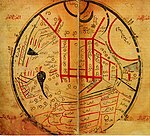
Mahmud al-Kashgari (1072 CE)
Qarakhanid scholar Mahmud al-Kashgari compiled a "Compendium of the languages of the Turks" in the 11th century. The manuscript is illustrated with a "Turkocentric" world map, oriented with east (or rather, perhaps, the direction of midsummer sunrise) on top, centered on the ancient city of Balasagun in what is now Kyrgyzstan, showing the Caspian Sea to the north, and Iraq, Azerbaijan, Yemen and Egypt to the west, China and Japan to the east, Hindustan, Kashmir, Gog and Magog to the south. Conventional symbols are used throughout- blue lines for rivers, red lines for mountain ranges etc. The world is shown as encircled by the ocean.
The map is now kept at the Pera Museum in Istanbul.
Al-Idrisi Mappa Mundi (1154 CE)
Main article: Tabula Rogeriana
The Arab geographer Al-Idrisi's incorporated the knowledge of Africa, the Indian Ocean and the Far East gathered by Arab merchants and explorers with the information inherited from the classical geographers to create one of the most accurate maps of the world to date.
The Tabula Rogeriana was drawn by Al-Idrisi in 1154 for the Norman King Roger II of Sicily, after a stay of eighteen years at his court, where he worked on the commentaries and illustrations of the map. The map, written in Arabic, shows the eurasian continent in its entirety, but only shows the northern part of the African continent.
Hereford Mappa Mundi (1300)

The Hereford Mappa Mundi is a T and O map dating to ca. 1300. The map is signed by one "Richard of Haldingham or Lafford". Drawn on a single sheet of vellum, it measures 158 cm by 133 cm. The writing is in black ink, with additional red and gold, and blue or green for water (with the Red Sea coloured red).
Kangnido world map (1402)

The Kangnido (Integrated Map of Historical Capitals) was a world map created in Korea in 1402. It was based on two Chinese maps and the unnamed maps of Korea and Japan. Among them, the Shengjiao Guangbei Tu by Li Zemin was a world map.
This is the best known example of the maps of the Mongol Empire, which enabled the integration of advanced Islamic science and traditional Chinese knowledge. Since most of the official maps are lost, relatively new manuscripts of private, supposedly less accurate maps are known today.
Like Istakhri's and al-Idrisi's, the map of the Mongol Empire depicts Africa, the Arabian Peninsula and Europe. It shows China in the way traditional Chinese ones do but also reflects the information of South Asia gathered by Muslim merchants.
De Virga world map (1411-1415)

The De Virga world map was made by Albertinus de Virga between 1411 and 1415. Albertin de Virga, a Venetian, is also known for a 1409 map of the Mediterranean, also made in Venice. The world map is circular, drawn on a piece of parchment 69.6x44 cm. It consists of the map itself, about 44 cm in diameter, and an extension containing a calendar and two tables.
Bianco world map (1436)
Main article: Bianco world map
Andrea Bianco's atlas of 1436 comprises ten leaves of vellum, measuring 29 X 38 cm., in an 18th century binding. The first leaf contains a description of the Rule of Marteloio for resolving the course, with the "circle and square", two tables and two other diagrams. The next eight leaves contain various navigation charts. The ninth leaf contains a circular world map measuring 25 cm in circumference. And the final leaf contains the Ptolemaic world map on Ptolemy's first projection, with graduation. Some believe Bianco's maps were the first to correctly portray the coast of Florida, as a macro-peninsula is attached to a large island labeled Antillia. Bianco also collaborated with Fra Mauro on the Fra Mauro world map of 1459.
Fra Mauro world map (1459)

The Fra Mauro map was made between 1457 and 1459 by the Venetian monk Fra Mauro. It is a circular planisphere drawn on parchment and set in a wooden frame, about 2 meters in diameter.
The original world map was made by Fra Mauro and his assistant Andrea Bianco, a sailor-cartographer, under a commission by king Afonso V of Portugal. The map was completed on April 24, 1459, and sent to Portugal, but did not survive to the present day. Fra Mauro died the next year while he was making a copy of the map for the Seignory of Venice, and the copy was completed by Andrea Bianco.
Martin Behaim globe (1492)
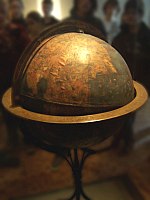
The world globe produced by Martin Behaim in 1492 is considered to be one of the first terrestrial globes ever made. It is constructed of a metal ball overlaid with a map of the world known at the time.
The Americas are not included yet, as the Columbus returned no sooner than March 1493 to Europe. It shows a rather enlarged Eurasian continent and an empty ocean between Europe and Asia. Interestingly, the Caribean islands may already be represented as well, even before Colombus's return, under the name of Saint Brendan island. Japan and Asian island are disproportionately large.
After 1492

Juan de la Cosa map (1500)
Juan de la Cosa, a Spanish cartographer, explorer and conquistador, born in Santoña in the northern autonomous region of Cantabria, made several maps of which the only survivor is the Mappa Mundi of 1500. It is the first known European cartographic representation of the Americas. It is now in the Museo Naval in Madrid. Reproductions of it are given by Humboldt in his Atlas géographique et physique.
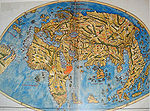
Cantino world map (1502)
Main article: Cantino planisphereThe Cantino planisphere is the earliest surviving map showing Portuguese discoveries in the east and west. It is named after Alberto Cantino, an agent for the Duke of Ferrara, who successfully smuggled it from Portugal to Italy in 1502. The map is particularly notable for portraying a fragmentary record of the Brazilian coast, accidentally discovered in 1500 by the Portuguese explorer Pedro Álvares Cabral and subsequently explored by Gonçalo Coelho and Amerigo Vespucci.

Piri Reis map (1513)
Main article: Piri Reis mapThe Piri Reis map is a famous world map created by 16th century Ottoman Turkish admiral and cartographer Piri Reis. The surviving third of the map shows part of the western coasts of Europe and North Africa with reasonable accuracy, and the coast of Brazil is also easily recognizable. Various Atlantic islands including the Azores and Canary Islands are depicted, as is the mythical island of Antillia. The map is noteworthy for its apparent south-eastward extension of the American continent to depict a southern landmass that some controversially claim is evidence for early awareness of the existence of Antarctica. Alternatively, it has been suggested that this is actually a record of the coast as far as Cape Horn, explored secretly by Portuguese navigators before 1507 (when it appeared on the Waldseemüller map) and bent south-eastward simply to fit on the parchment.
See also
- History of cartography
- Mappa mundi
- World map
- Here be dragons
- Terra Incognita
- Theatrum Orbis Terrarum, considered to be the first true modern atlas.
- Vinland Map, a 15th century map of disputed authenticity
- Caverio map, made in 1505.
- Waldseemüller map, made in 1507; a corrected version was released in 1513.
- Johannes Schöner globe, made in 1520.
- The "Zheng He map", a world map dated to the 17th century but claimed to be a copy of an early 15th century map.
- Nebra sky disk, a Bronze Age "map" of the cosmos.
- Web mapping
Notes
- Siebold, Jim Slide 103 via henry-davis.com - accessed 2008-02-04
- Finel, Irving (1995). A join to the map of the world: A notable discover. pp. 26–27.
- Source
- Michael Livingston, Modern Medieval Map Myths: The Flat World, Ancient Sea-Kings, and Dragons, 2002.
- Siebold, Jim Slide 210 monograph: Cottoniana or Anglo-Saxon Map, via henry-davis.com - accessed 2008-02-04
- 81 - The First Turkish World Map, by Kashgari (1072) « Strange Maps
External links
- Ancient Atlas PDF
- Index of Maps of the Early Medieval Period 400-1300 A.D
- Mapping History - a learning resource from the British Library
- Geography And Map Reading Room at the Library of Congress
| Atlas | |
|---|---|